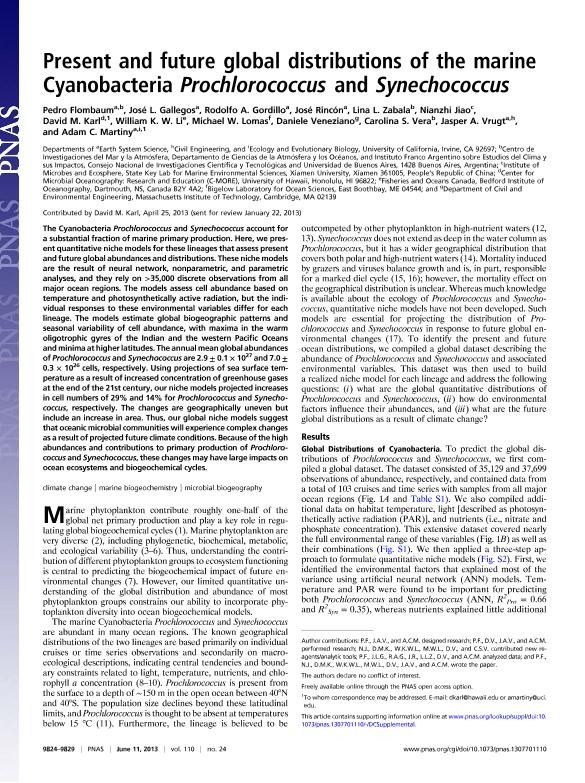Artículo
Present and future global distributions of the marine Cyanobacteria Prochlorococcus and Synechococcus
Flombaum, Pedro ; Gallegos, José L.; Gordillo, Rodolfo A.; Rincon, José; Zabala, Lina L.; Jiao, Nianzhi; Karl, David M.; Li, William K. W.; Lomas, Michael W.; Veneziano, Daniele; Vera, Carolina Susana
; Gallegos, José L.; Gordillo, Rodolfo A.; Rincon, José; Zabala, Lina L.; Jiao, Nianzhi; Karl, David M.; Li, William K. W.; Lomas, Michael W.; Veneziano, Daniele; Vera, Carolina Susana ; Vrugt, Jasper A.; Martiny, Adam C.
; Vrugt, Jasper A.; Martiny, Adam C.
 ; Gallegos, José L.; Gordillo, Rodolfo A.; Rincon, José; Zabala, Lina L.; Jiao, Nianzhi; Karl, David M.; Li, William K. W.; Lomas, Michael W.; Veneziano, Daniele; Vera, Carolina Susana
; Gallegos, José L.; Gordillo, Rodolfo A.; Rincon, José; Zabala, Lina L.; Jiao, Nianzhi; Karl, David M.; Li, William K. W.; Lomas, Michael W.; Veneziano, Daniele; Vera, Carolina Susana ; Vrugt, Jasper A.; Martiny, Adam C.
; Vrugt, Jasper A.; Martiny, Adam C.
Fecha de publicación:
04/2013
Editorial:
National Academy of Sciences
Revista:
Proceedings of the National Academy of Sciences of The United States of America
ISSN:
0027-8424
Idioma:
Inglés
Tipo de recurso:
Artículo publicado
Clasificación temática:
Resumen
The Cyanobacteria Prochlorococcus and Synechococcus account for a substantial fraction of marine primary production. Here, we present quantitative niche models for these lineages that assess present and future global abundances and distributions. These niche models are the result of neural network, non-parametric, and parametric analyses, and rely on >35,000 discrete observations from all major ocean regions. The models assess cell abundance based on temperature and photosynthetically active radiation (PAR); but the individual responses of each lineage differ to these environmental variables. The models estimate global biogeographic patterns and seasonal variability of cell abundance with maxima in the warm oligotrophic gyres of the Indian and the western Pacific Oceans, and minima at higher latitudes. The annual mean global abundances of Prochlorococcus and Synechococcus are 2.9±0.1 x1027 and 7.0±0.3 x1026 cells, respectively. Using projections of sea-surface temperature as a result of increased concentration of greenhouse gases at the end of the 21st century, our niche models projected increases in cell numbers of 28 and 14% for Prochlorococcus and Synechococcus, respectively. The changes are geographically uneven but include an increase in areas, where both lineages are currently abundant, an expansion towards higher latitudes, and for Synechococcus, mid-latitude regions with declining abundances. Thus, our global niche models suggest that oceanic microbial communities will experience complex changes even just considering projected future climate conditions. Due to the high abundances and contributions to primary production of Prochlorococcus and Synechococcus, these changes may have large impacts on ocean ecosystems and biogeochemical cycles.
Palabras clave:
Cianobacterias
,
Modelo de Nicho
Archivos asociados
Licencia
Identificadores
Colecciones
Articulos(CIMA)
Articulos de CENTRO DE INVESTIGACIONES DEL MAR Y LA ATMOSFERA
Articulos de CENTRO DE INVESTIGACIONES DEL MAR Y LA ATMOSFERA
Citación
Flombaum, Pedro; Gallegos, José L.; Gordillo, Rodolfo A.; Rincon, José; Zabala, Lina L.; et al.; Present and future global distributions of the marine Cyanobacteria Prochlorococcus and Synechococcus; National Academy of Sciences; Proceedings of the National Academy of Sciences of The United States of America; 110; 24; 4-2013; 9824-9829
Compartir



